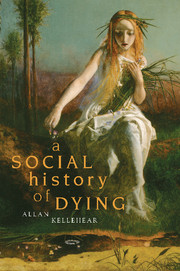Book contents
- Frontmatter
- Contents
- Acknowledgements
- Introduction
- Part I THE STONE AGE
- Part II THE PASTORAL AGE
- Part III THE AGE OF THE CITY
- Part IV THE COSMOPOLITAN AGE
- Chapter Ten The Exponential Rise of Modernity
- Chapter Eleven The Birth of the Shameful Death
- Chapter Twelve The Final Challenge: Timing Death
- Conclusion
- Bibliography
- Index
Chapter Eleven - The Birth of the Shameful Death
Published online by Cambridge University Press: 22 September 2009
- Frontmatter
- Contents
- Acknowledgements
- Introduction
- Part I THE STONE AGE
- Part II THE PASTORAL AGE
- Part III THE AGE OF THE CITY
- Part IV THE COSMOPOLITAN AGE
- Chapter Ten The Exponential Rise of Modernity
- Chapter Eleven The Birth of the Shameful Death
- Chapter Twelve The Final Challenge: Timing Death
- Conclusion
- Bibliography
- Index
Summary
There are major ironies in our Cosmopolitan experience of dying. Nowadays, at what seems to be the high tide of our modern, spreading achievements in public health, technology and life-expectancy, dying is increasingly becoming an out-of-sight and mistimed experience. Our medical technologies, public health screening programs and clinical skills allow for the most penetrating diagnosis of even the most silent diseases, and yet an accurate diagnosis of a medical condition has little relevance to the social consequences of dying of contagion and poverty, or frail old age. In the industrial world, if we can survive the early threats of accidents and suicides of youth, the mid-life cancer scares and heart attacks, most of us will end up with an assortment of diseases that will not provide us with a clear death-bed scene for ourselves or our families. Creeping arthritis, organ failure or dementia, and sudden body system failures such as strokes, pneumonia or accidental falls will deny most of us a good death or even a well-managed one.
To make matters worse, between 17 and 30 per cent of the elderly (depending on who you read) will experience their dying in a nursing home (Brock & Foley 1998: 53; Sullivan 2002; Weitzen et al. 2003; Flory et al. 2004). Although nursing homes do not necessarily weaken family ties, excluding people from decision-making certainly does reduce the quality of relationships (Minichiello 1989) and this is a common cultural situation for people in these places.
- Type
- Chapter
- Information
- A Social History of Dying , pp. 213 - 233Publisher: Cambridge University PressPrint publication year: 2007



